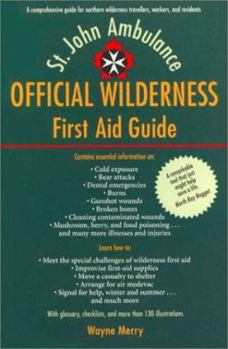Official Wilderness First Aid Guide
Select Format
Select Condition 
Book Overview
No Synopsis Available.
Format:Paperback
Language:English
ISBN:0771082509
ISBN13:9780771082504
Release Date:March 1994
Publisher:McClelland & Stewart
Length:385 Pages
Weight:1.26 lbs.
Dimensions:1.0" x 5.5" x 8.5"
Customer Reviews
1 rating
Best wilderness first aid guide out there
Published by Thriftbooks.com User , 24 years ago
I've been using Wayne Merry's Wilderness First Aid Guide to teach St. John Ambulance Wilderness First Aid courses since 1995. If you only read one wilderness first aid book, this is the one to read.Published in 1994, the Wilderness First Aid Guide was developed under a grant from the Donner Foundation to create first aid training that would be relevant to remote Northern First Nation and Inuit communities where help is often days away. It remains one of the best Wilderness First Aid publications available today.It's divided into 4 sections: first response, caring for casualties, wilderness injuries, and wilderness illnesses. There are sections at the end on: improvising first aid supplies, first aid kits, medications, signaling for help, and first aid checklists for documenting a rescue. Each problem is described in context, with many helpful examples and illustrations, and with sections on prevention, recognition of signs and symptoms ("How to tell") and the appropriate first aid ("What to do"). Wayne differentiates between the first aid needed if help is an hour away and first aid if help is days away.In a wilderness setting, a rescue involves 8 steps. 1. Survey scene, 2. Find/ treat life-threatening problems, 3. Move casualty to shelter (or erect shelter over casualty), 4. Perform secondary survey and document findings/treatment, 5. Make evacuation decision, 6. Signal/send for help, 7. Provide "second aid" (warmth, fluids, food, & waste management), and 8. Move casualty to help. Most other wilderness first aid books focus on the help needed in the first hour, but are sketchy beyond that. The Official Wilderness First Aid Guide explains the mechanisms/physiology underlying serious wilderness problems like hypothermia, dehydration, and shock in simple language, helping first aiders understand not just what to do but why. The chapter on moving a casualty to shelter details over 14 short distance lifting techniques for 1, 2 or multiple rescuers. The chapter on moving a casualty to help details techniques for stretcher building, carrying, and belaying, and reviews the pros, cons and special considerations of various land (ATV, snowmobile, komatik, dogsled), water (canoe, cabin cruiser) and air (airplane, helicopter) evacuations. There are also comprehensive chapters on second aid (taking care of someone while you wait for help), keeping warm, bear attacks, and abdominal complaints. These are crucial wilderness first aid skills that other manuals cover in a page or two, if they talk about them at all. Currently, this book is used as a text for the four day wilderness first aid courses offered by St. John Ambulance in British Columbia, Alberta, Ontario, Quebec, and New Brunswick. It has been translated into German, and in Germany you must have a Wilderness First Aid Certificate in order to purchase a Personal Locator Beacon rescue device.I recommend this book highly to anyone who spends time in the outdoor






